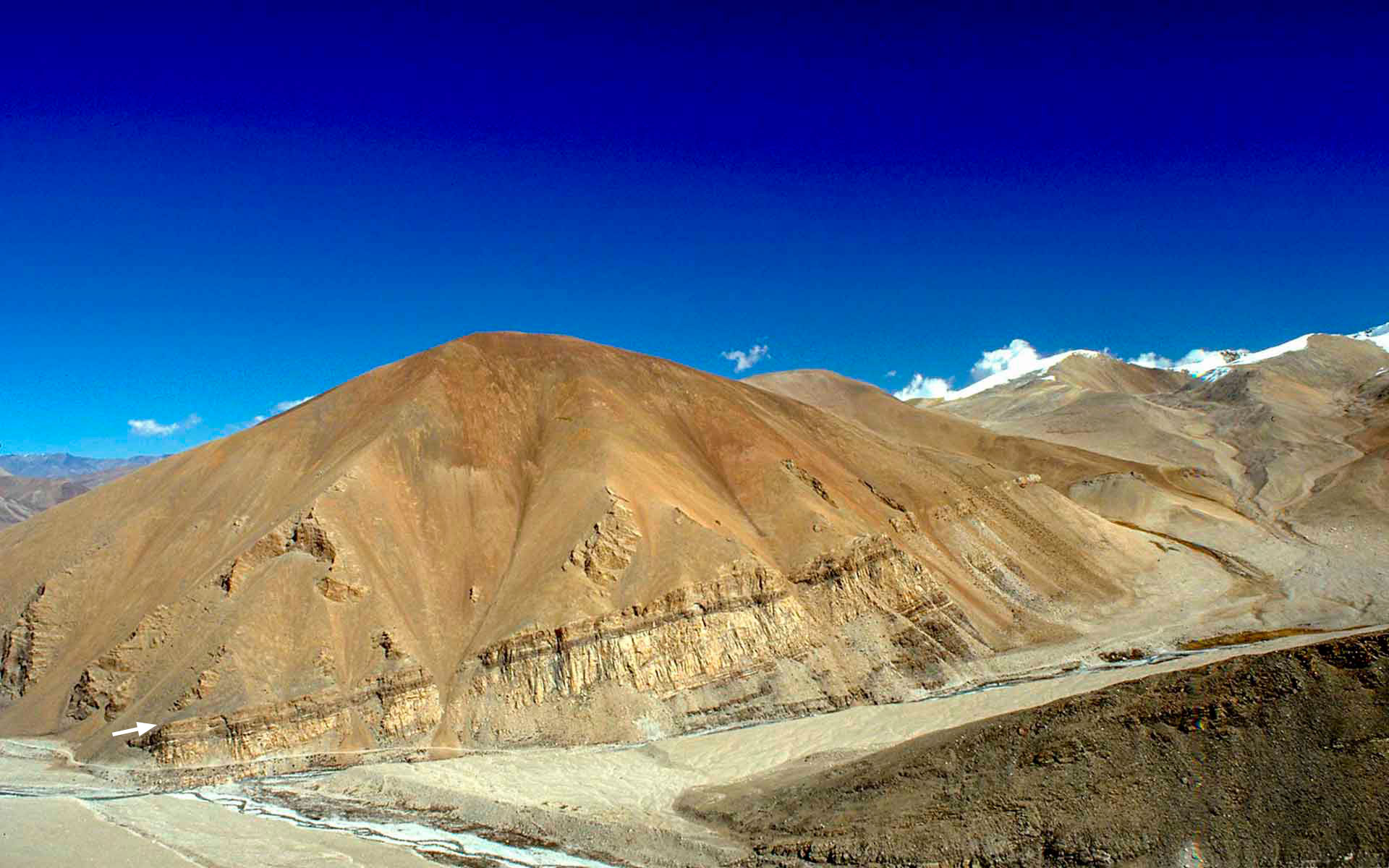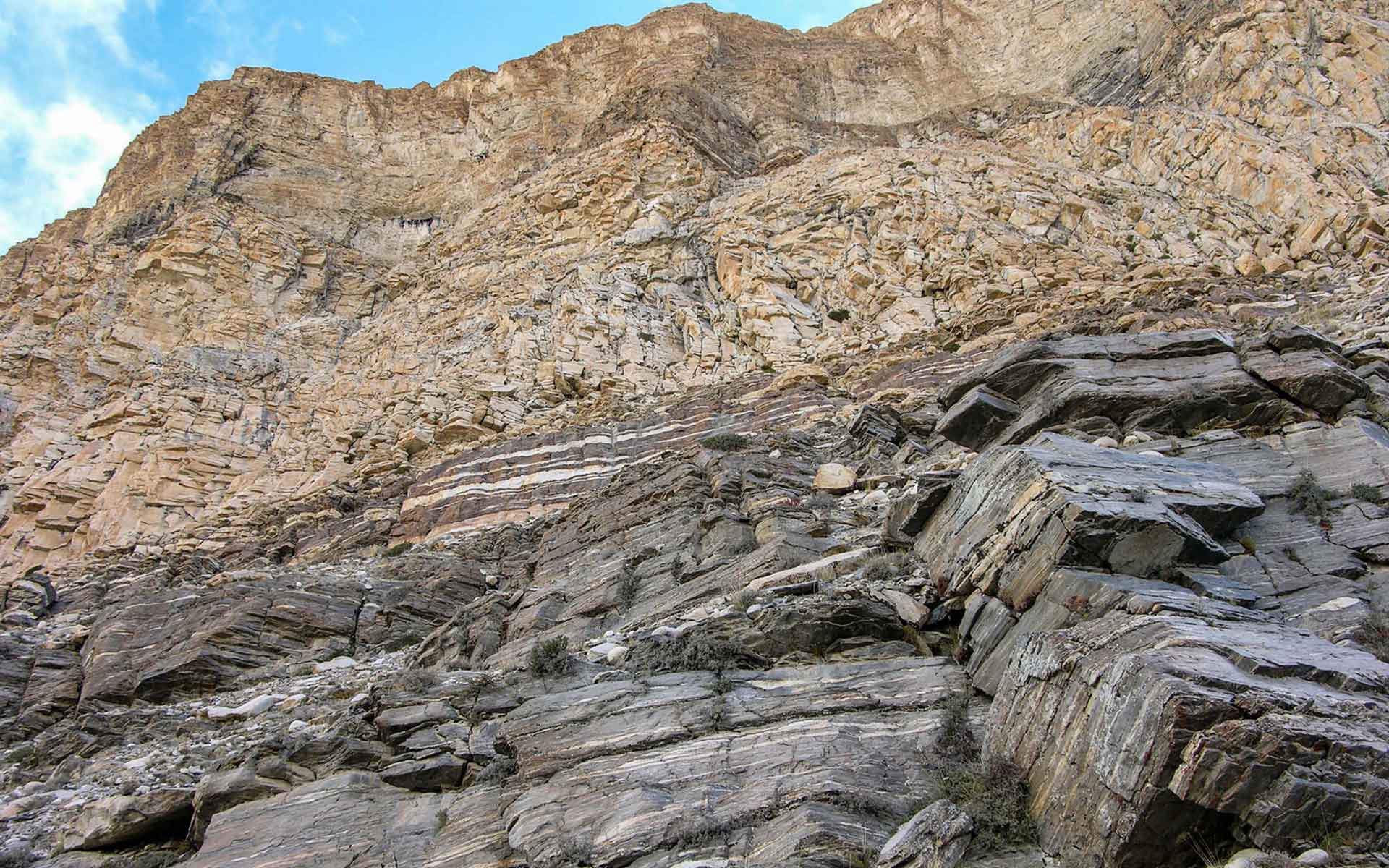
The STDS (White arrow just above the withish rocks corresponding to deformed Miocene leucogranite) dipping to the North (top-down-to-the North sense of shear), Rongbuk valley. Upper part of the photo: Tethyan Sedimentary rocks; Lower part of the photo: high-grade metamorphic rocks belonging to the Greater Himalaya.
Geological Period
Miocene
Main geological interest
Tectonics
Location
Rongbuk Valley, southern Tibet. China.
28°16’02.0″N, 86°48’36.0″E
The STDS (White arrow just above the withish rocks corresponding to deformed Miocene leucogranite) dipping to the North (top-down-to-the North sense of shear), Rongbuk valley. Upper part of the photo: Tethyan Sedimentary rocks; Lower part of the photo: high-grade metamorphic rocks belonging to the Greater Himalaya.
The place where the highest regional scale low-angle normal fault of the earth can be directly observed.
The discovery during the 1980’s of orogen-perpendicular extension in the Himalayas along the South Tibetan Detachment System (STDS) coeval with compression revolutionized models of orogenic belts (Burg et al., 1984) and improved considerably understanding of their tectonic-metamorphic evolution. The exhumation of deeply seated metamorphic rocks in the core of the Himalayan belt was made possibly by displacement on the STDS. Rongbuk Valley is of scientific importance because in this location the complex STDS architecture, with brittle and ductile branches, was described and formalized (Carosi et al., 1998). Moreover, here the lower ductile structure was identified as the major extensional feature.
- Geological description
The recognition of syn-collisional extensional structures, referred as the South Tibetan Detachment System (STDS), in the Himalaya deeply influenced Plate Tectonics since the 1980’s. STDS is a set of orogen-parallel normal-sense faults and shear zones, traced along the entire strike length (c. 2000 km) of the Himalaya. This structure, exposed on the Everest summit, is the highest fault on the earth. Along the Rongbuk valley (S Tibet), the STDS is easily accessible and nicely exposed, where a complex architecture is documented by the occurrence of two major fault zones showing top-to-NE normal kinematics. The lower one is a wide ductile shear zone, more than 1 km thick, juxtaposing medium grade rocks (North Col Formation, NCF) with high grade metamorphic rocks of the Greater Himalayan Sequence. More than 5 km of vertical displacement is accommodated along this ductile branch. The upper fault is instead a low-angle brittle fault zone characterized by a metric thick cataclasites, accommodating at least 1600 m of vertical displacement. Along this brittle structure slightly metamorphosed Ordovician limestone is juxtaposed against the NCF. In this place, it was demonstrated that the lower ductile shear must be considered the main extensional feature of the STDS.
- Scientific research and tradition
Because of its importance in understanding the tectonic evolution of the Himalaya, the The South Tibetan Detachment System in Rongbuk Valley has been subject to many investigations over the last 35 years. The initial description is that of Burg et al. (1984). Subsequent investigations are those of Burchfiel et al., 1992; Carosi et al., 1998; Searle et al., 2003; Corthouts et al., 2016; and Waters et al., 2019.
- Reference
Burchfiel, B.C. et al. (1992) ‘The South Tibetan Detachment System, Himalayan Orogen: Extension Contemporaneous With and Parallel to Shortening in a Collisional Mountain Belt’, Geological Society of America Special Paper, 269, p. 41. Available at: https://doi.org/10.1130/SPE269-p1.
Burg, J.P. et al. (1984) ‘Deformation of leucogranites of the crystalline Main Central Sheet in southern Tibet (China)’, Journal of Structural Geology, 6(5), pp. 535–542. Available at: https://doi.org/10.1016/0191-8141(84)90063-4.
Carosi, R. et al. (1998) ‘The south Tibetan detachment system in the Rongbuk valley, Everest region. Deformation features and geological implications’, Journal of Asian Earth Sciences, 16(2), pp. 299–311. Available at: https://doi.org/10.1016/S0743-9547(98)00014-2.
Corthouts, T.L., Lageson, D.R. and Shaw, C.A. (2016) ‘Polyphase deformation, dynamic metamorphism, and metasomatism of Mount Everest’s summit limestone, east central Himalaya, Nepal/Tibet’, Lithosphere, 8(1), pp. 38–57. Available at: https://doi.org/10.1130/L473.1.
Searle, M.P. et al. (2003) ‘The structural geometry, metamorphic and magmatic evolution of the Everest massif, High Himalaya of Nepal-South Tibet’, Journal of the Geological Society, 160(3), pp. 345–366. Available at: https://doi.org/10.1144/0016-764902-126.
Waters, D.J. et al. (2019) ‘Structural and thermal evolution of the South Tibetan Detachment shear zone in the Mt Everest region, from the 1933 sample collection of L. R. Wager’, Geological Society of London Special Publications, 478(1), pp. 335–372. Available at: https://doi.org/10.1144/SP478.17.
- Author(s)
Rodolfo Carosi
Università degli Studi di Torino, Italy
Chiara Montomoli
Università degli Studi di Torino, Italy
Salvatore Iaccarino
Università degli Studi di Torino, Italy


